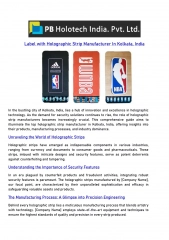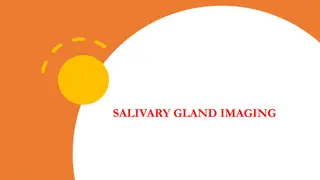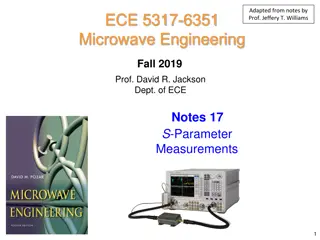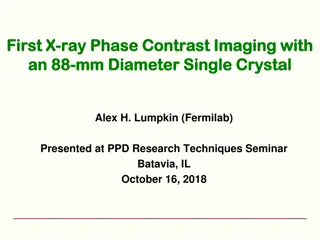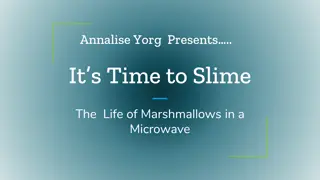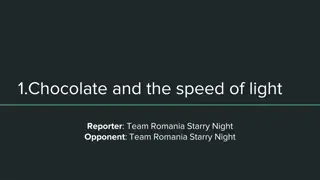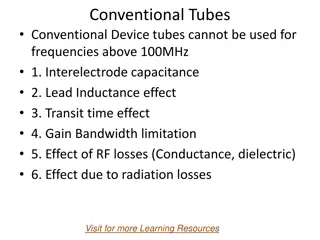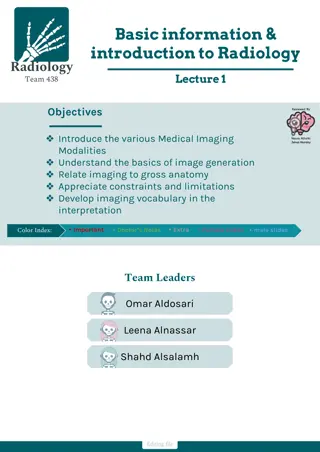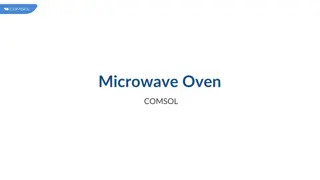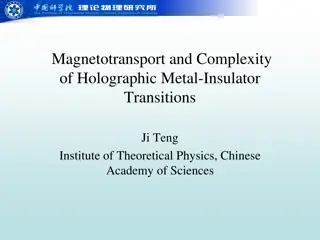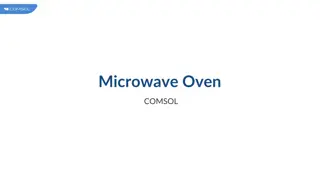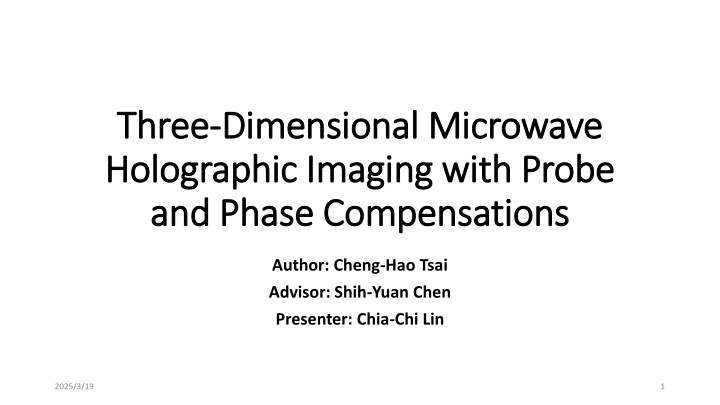
Microwave Holographic Imaging: Theory and Applications
Explore the innovative approach of Three-Dimensional Microwave Holographic Imaging with Probe and Phase Compensations. Learn about its characteristics, application in various fields, data collection process, and theoretical foundations. Discover how this technology can revolutionize non-ionizing, concealed weapon inspection, buried object detection, and indoor human tracking while remaining safe and cost-effective.
Download Presentation

Please find below an Image/Link to download the presentation.
The content on the website is provided AS IS for your information and personal use only. It may not be sold, licensed, or shared on other websites without obtaining consent from the author. If you encounter any issues during the download, it is possible that the publisher has removed the file from their server.
You are allowed to download the files provided on this website for personal or commercial use, subject to the condition that they are used lawfully. All files are the property of their respective owners.
The content on the website is provided AS IS for your information and personal use only. It may not be sold, licensed, or shared on other websites without obtaining consent from the author.
E N D
Presentation Transcript
Three Three- -Dimensional Microwave Dimensional Microwave Holographic Imaging with Probe Holographic Imaging with Probe and Phase Compensations and Phase Compensations Author: Cheng-Hao Tsai Advisor: Shih-Yuan Chen Presenter: Chia-Chi Lin 2025/3/19 1
Outline Outline Introduction Characteristic Application Step of 3-D microwave holographic imaging Theory of probe compensated holographic imaging Open-circuit voltage Voc Added FFT into Voc The way to increase the stability Analysis of Proposed Probe-Compensated Holographic Imaging Plane-Wave Expansion designing the low pass filter cross range resolution Phase compensation Conditioning of Least-Squares Problems Simulation Measurement 2025/3/19 2
Introduction 2025/3/19 3
Characteristic Characteristic Application Application Characteristic Penetrating non-ionizing Application conceal weapon inspection buried object discovery indoor human detection harmless to human bodies cost-effective and low-profile 2025/3/19 4
Step of 3 Step of 3- -D microwave holographic imaging D microwave holographic imaging data collection single-probe dual-probe post processing by the holographic imaging algorithms (FFT). 2025/3/19 5
Theory of probe compensated holographic imaging 2025/3/19 6
Theory of probe Theory of probe compensated holographic imaging compensated holographic imaging In microwave imaging, a nonlinear integral equation: 2025/3/19 7
open open- -circuit voltage circuit voltage Voc Voc derived from the reciprocity theorem( ) 2025/3/19 8
open open- -circuit voltage circuit voltage Voc Voc By the volume equivalence principle assumed that the target is made of linear, isotropic, non-dispersive, and non-magnetic material 2025/3/19 9
Added FFT into Added FFT into Voc Voc 2025/3/19 10
Added FFT into Added FFT into Voc Voc Add frequency condition then rewrite them into matrix form Ax=b: The unknown permittivity distributions on different observation z- planes are thus: 2025/3/19 11
The way to increase the stability The way to increase the stability auxiliary equations are introduced with the aid of a prior information, namely the lossless condition, then its complex permittivity (x, y, zn) is real-valued: 2025/3/19 12
Analysis of Proposed Probe Compensated Holographic Imaging 2025/3/19 13
Plane Plane- -Wave Expansion Wave Expansion complicated propagation behavior could be decomposed into many simple plane waves traveling in different directions came into play. Electric field E(x, y, z) propagating in this space z>0 should satisfies the Helmholtz equation: FFT 2025/3/19 14
Plane Plane- -Wave Expansion Wave Expansion Also, the source-free Gauss s law is considered in the half space z>0: apply the 2-D spatial Fourier transform with respect to x and y on (3.6) and consider the characteristic in (3.5) as z = 0: 2025/3/19 15
Plane Plane- -Wave Expansion Wave Expansion Imply that if its argument (kx, ky) lies outside the circle of radius k centered at the origin of the spatial-frequency domain (k-circle) as shown in Figure: 2025/3/19 16
Plane Plane- -Wave Expansion Wave Expansion 2025/3/19 17
Phase compensation Phase compensation To describe this characteristic by G (kx, ky, zn, fm), a simple relation between G (kx, ky, zn, fm) s on different observation z-planes is needed: assumed that a directive probe antenna is used, i.e., G (kx, ky, zn, fm) dominates as both kx and ky are small 2025/3/19 18
Phase compensation Phase compensation if some dielectric material is on the path of the plane wave, the phase delay would be slightly larger than the free-space one. This additional phase delay could be roughly compensated based on a simple ray model, The additional phase delay m could readily be derived as: 2025/3/19 19
Phase compensation Phase compensation 2025/3/19 20
Conditioning of Least Conditioning of Least- -Squares Problems Squares Problems ?? ? ? ? ? (antenna independent least squares problem) To quantify the independency between columns of A in , the condition number, which has been widely used in least squares problems, is defined below: 2025/3/19 21
Conditioning of Least Conditioning of Least- -Squares Problems Squares Problems The difference vectors between any two adjacent columns of A are the same and can be expressed as: It can be further characterized by the ratio between its entries at the highest and lowest frequencies: 2025/3/19 22
Conditioning of Least Conditioning of Least- -Squares Problems Squares Problems the larger the fractional bandwidth, the lower the sensitivity of the least square: 2025/3/19 23
Low Low- -pass filter pass filter a numerical low-pass filter in the spatial frequency domain is needed to sieve out the least squares problems that are worth solving. while scanning to the position that is the most distant from the center of the scanning aperture, could still see the target. Two important things that affect resolution radiation pattern of the probe antenna dimensions of the scanning aperture 2025/3/19 24
Low Low- -pass filter pass filter probe antenna scanning aperture save the computational time eliminate noises 2025/3/19 25
crossrange cross range resolution resolution Due to discretizing measurement in practice, sampling in both space and frequency domains is required in the proposed algorithm. In the spatial domain: based on the Nyquist sampling theorem In the frequency domain: related to solving the least squares problem 2025/3/19 26
crossrange cross range resolution resolution The range resolution z is thus mainly determined by the spacing between adjacent observation z planes z. The range resolution z center/10 can be achieved by properly increasing FBW to ensure a satisfactorily low condition number. 2025/3/19 27
SimulationMeasurement 2025/3/19 28
Center frequency f10GHz Wavelength 30mm Size 18 18 3 ??3 FBW 20% (9 11 GHz) ?? 2 Nz=3 x = y =6mm z =3mm f = 0.5GHz Half-wavelength dipole Patch antenna (31-mil RT/Duroid 5880 dielectric slab) 2025/3/19 29
Discussion 1 Discussion 1 Comparison between a half-wavelength dipole and a microstrip patch antenna as the probe antenna. 2025/3/19 30
using the proposed algorithm using algorithm proposed in [17] Half-wave dipole Patch antenna 2025/3/19 31
Discussion 2 Discussion 2 Demonstrate the efficacies of the spatial filtering, auxiliary equation, and phase compensation method in the proposed algorithm. 2025/3/19 32
1. using the proposed algorithm 2. auxiliary equation 1. using the proposed algorithm 2. spatial filtering 2025/3/19 33
1. using the proposed algorithm 2. spatial filtering 3. auxiliary equation (a) 1. using the proposed algorithm 2. spatial filtering 3. auxiliary equation 4. phase compensation (b) (c) 2025/3/19 34
Discussion 3 Discussion 3 Can we apply the auxiliary equation on the low-loss dielectrics? 2025/3/19 35
with the auxiliary equation Except for the loss tangents and the spatial samplings reduced to x = y = 3.6 mm without the auxiliary equation. 2025/3/19 36
Discussion 4 Discussion 4 Investigate the influence of FBW on numerical sensitivity. 2025/3/19 37
2025/3/19 38



